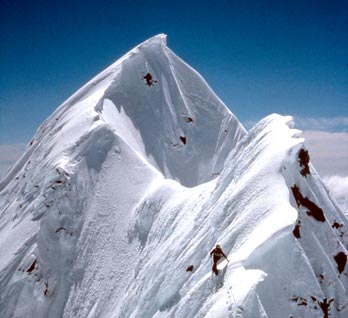Story summary
New Zealand’s main mountaineering areas are in the South Island, especially the Southern Alps. The North Island has Mt Taranaki and Mt Ruapehu.
Early days
Mountains were sacred to Māori. This prevented them climbing the peaks.
Europeans began exploring in the mid-19th century. James Bidwill climbed Mt Ngāuruhoe in 1839, and in 1855 Maria Atkinson made the first major climb by a woman – to the top of Taranaki maunga.
Conquering Aoraki/Mt Cook
Aoraki/Mt Cook in the Southern Alps is New Zealand’s highest peak, at 3,724 metres. In 1894 a group of New Zealand climbers wanted to beat an Englishman to the top, and on Christmas Day they did. By 1955, there had been 100 ascents of Aoraki/Mt Cook. Many climbers have died on the mountain.
Guides
In 1895 the government bought the Hermitage hotel, near Aoraki/Mt Cook, and employed mountaineers to be alpine guides there. They took serious climbers into the Southern Alps, cutting steps in the ice. With a guide, Australian Freda Du Faur became the first woman to climb Aoraki/Mt Cook.
At this time, mountaineers used ice-axes and hemp ropes, and wore goggles. They had canvas tents and sometimes used horses to carry their equipment and supplies. Food included beans, rice, bacon and dried fruit.
Tourists still use guides today.
Climbing takes off
During the 1930s, many young people began mountaineering. They did not take guides to cut steps for them. Instead they used crampons – spikes on their boots that stopped them slipping on ice. After the Second World War, equipment such as ice screws, nylon ropes and lightweight stoves made climbing quicker and easier.
Ridges, faces and rock climbing
By the 1950s all the difficult ridges of major peaks had been climbed. The next challenge was climbing faces – the slopes below ridges, which are harder to climb because they are so steep. One of the toughest was Aoraki/Mt Cook’s Caroline Face, first climbed in 1970.
Today rock climbing and indoor climbing walls are popular.
Famous Kiwi mountaineers
- In 1953, New Zealander Edmund Hillary and Sherpa Tenzing Norgay of Nepal were the first to reach the top of Mt Everest in the Himalayas.
- Murray Jones and Graeme Dingle climbed six difficult north faces in Europe in 1968.
- Lydia Bradey became the first woman to reach the top of Mt Everest without using an oxygen tank in 1988.
- Rob Hall and Gary Ball climbed seven summits on seven continents in 1990.
- Mark Inglis, who had lost his legs to frostbite in 1982, climbed Mt Everest in 2006.





